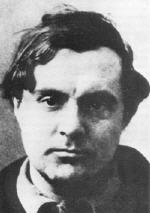
1884 - 1920. Born in Livorno, Italy, Modigliani spent almost his entire brief yet influential career in Paris. He began as a sculptor, with Brancusi as his master. Upon the outbreak of WWI, Modigliani turned to painting, influenced by the art of Africa and Oceania. The flat, masklike faces of his portraits, with almond eyes and elongated features, are unique to his style. While he fraternized with the cubists, the Art Deco masters, Toulouse-Lautrec, and even Picasso, Modigliani remained independent of any movement. His art is truly unique.
During the early 1900s in Paris, the Italian painter and sculptor Amedeo Modigliani, (b. July 12, 1884, d. Jan. 24, 1920), developed a unique style. Today his graceful portraits and lush nudes at once evoke his name, but during his brief career few apart from his fellow artists were aware of his gifts. Modigliani had to struggle against poverty and chronic ill health, dying of tuberculosis and excesses of drink and drugs at the age of 35.